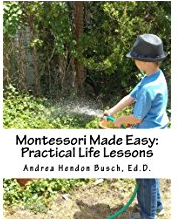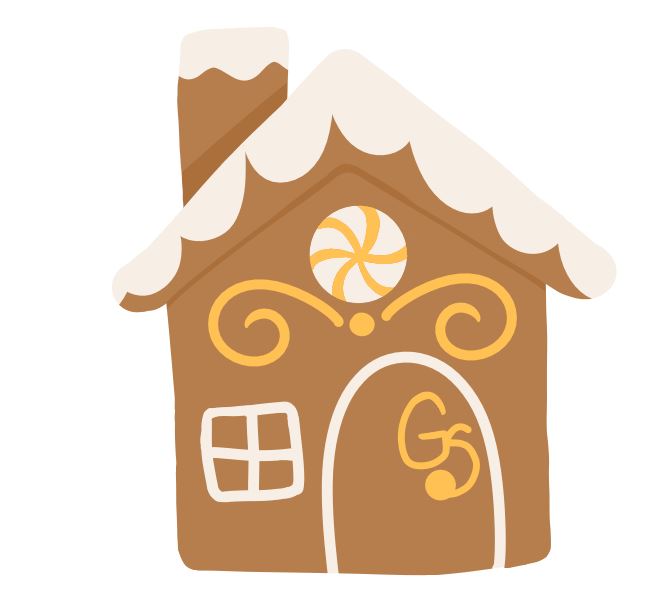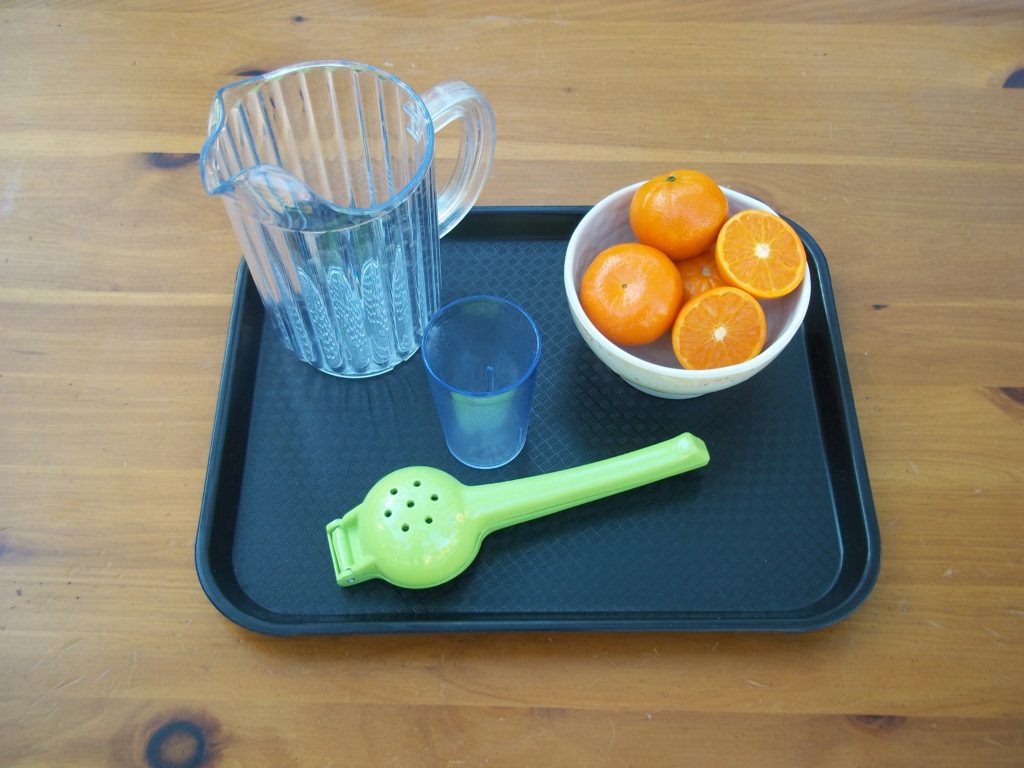
Practical Life Environment
The Montessori Practical Life environment provides a calm sense of order. It is based on a prepared environment. The materials are prepared and set out attractively to provide interest for the children. The children select materials from the shelf that they would like to work on and are allowed to concentrate on that work for as long as they would like to do so. This prepared environment, level of choice, and ability to concentrate without interruption provide a calm and pleasant learning environment. Parents who are new to the Montessori environment are often amazed by the level of calm and order as the children are self-motivated to work on and learn from materials in the environment.
Setting up a Practical Life area is easy. In order to provide your children with a Montessori Practical Life area, choose a shelf to display your materials. If your space allows, utilize a number of shelving units in your Montessori Practical Life area. Keep them all in one area in order to create a specific area for completing the Practical Life activities. Organize your space by types of materials; such as one shelf for pouring and spooning activities; another shelf for cleaning materials; and another shelf for art and design materials. In a Montessori format, the materials are laid out on a shelf and the each child is allowed to choose the particular activity that he wants to work with. The child should be allowed to work with the materials for as long as he wants; repeating and perfecting the skills for the activity. Once the child is through with working on that particular activity, he should put it back into the basket or tray neatly and return the materials to the shelf. He may then choose another activity to work on.
Shelf Materials
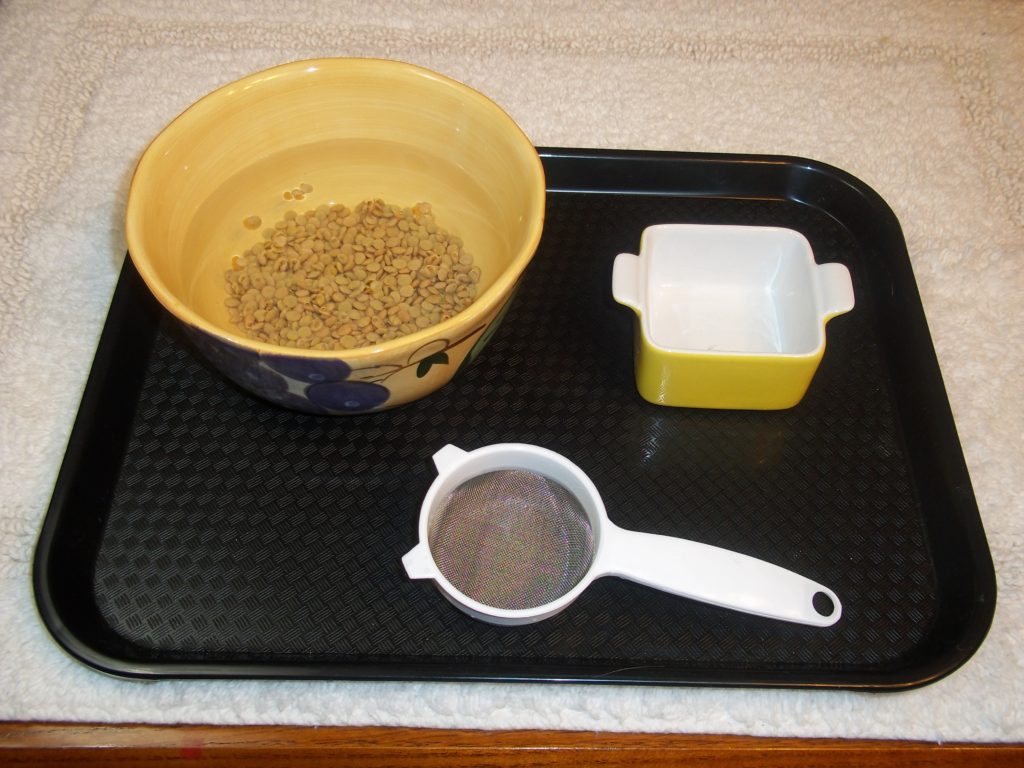
If you are setting up a Practical Life area in a traditional school or child care center you may have space limitations as you try to create an area for Practical Life among your other classroom needs. Likewise, if you are working out of your home, creating a dedicated space can be challenging. In such cases, you can create a single shelf of materials and rotate the items. If you like the idea of a more traditional program with “learning centers” rather than shelves of open materials, you can set up your Practical Life activities as centers.
You will have fewer options for children to choose from at one time. This provides a very different type of environment from the Montessori classroom layout; however, it will allow you to utilize the wonderful Practical Life activities within the scope of your own home-based learning design, the traditional school classroom model, and even the learning center model which is very popular in child care centers.
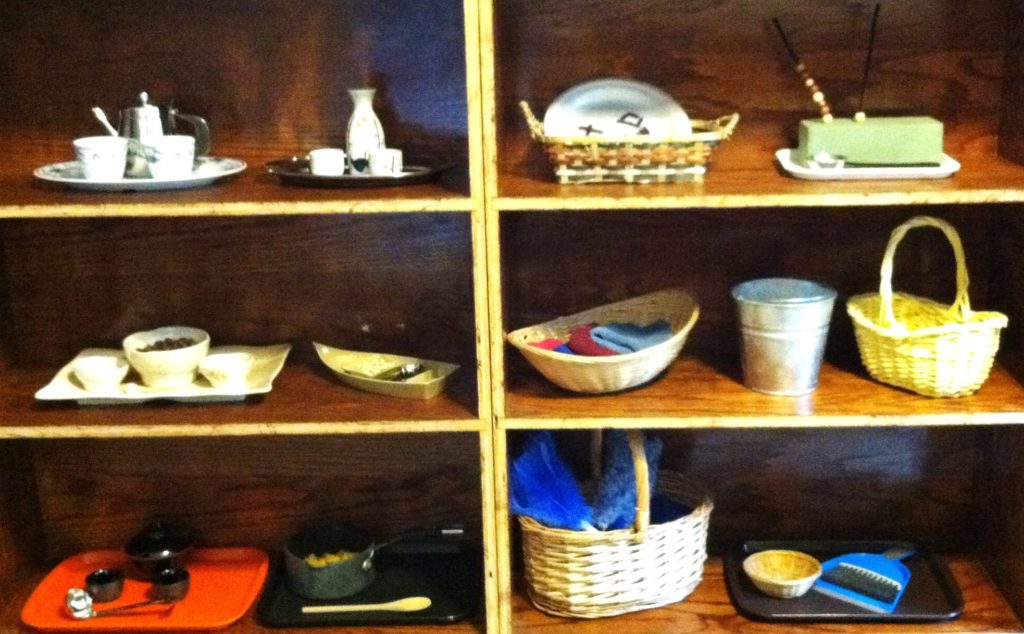
This is an example of a shelving unit with activities laid out in complete sets. It shows a variety of activities, colors, textures, and containers displayed simply and attractively. The use of trays, baskets, and wooden boxes create a means to contain all of the materials for activities as well as a way to easily carry the materials to a mat or table.
Stable & Rotating Shelf Activities
In the Montessori environment, each activity has a specific place on the shelf. Children are taught to pay attention to where each activity belongs. As a child chooses an activity to work with, he should pay attention to where it belongs and be sure to return it to the correct place when he is done.
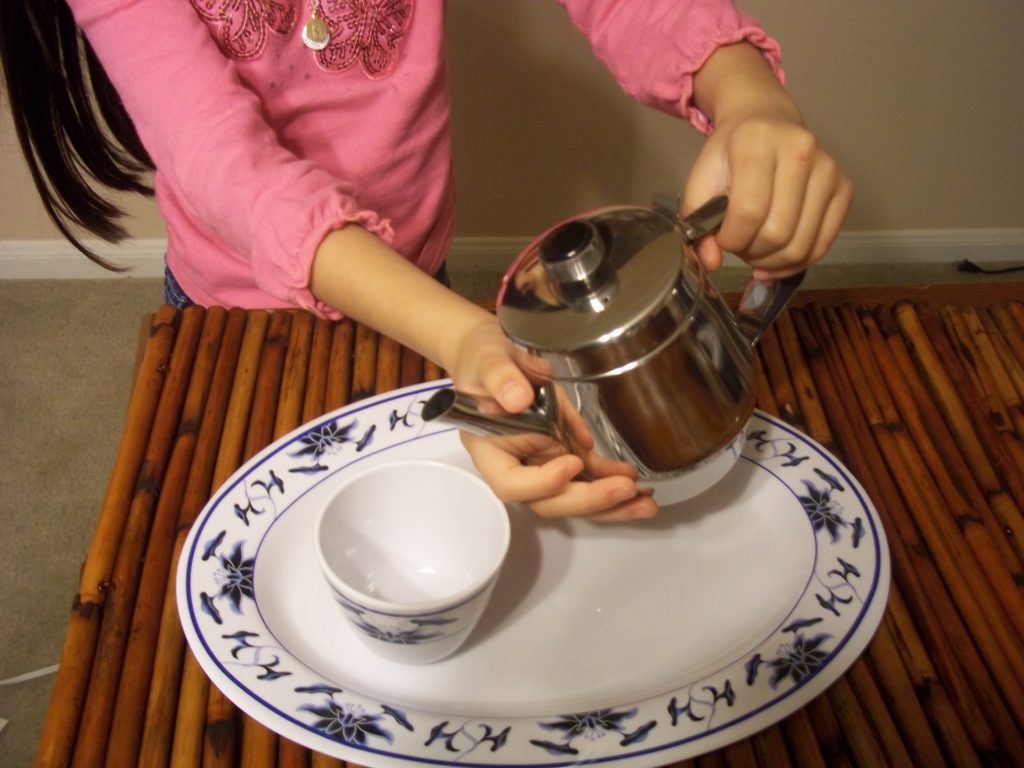
Some Practical Life materials in the book are perfect for shelf materials. These are the materials that can sit on a shelf; be used by a child; and then be returned to the shelf for the next child to use. These are materials that are relatively neat, dry, and do not need replenishing on a regular basis.
Throughout the book, there are also materials which may be placed on a shelf but at the teacher or parent’s option, may be better suited for a center type area. These would be materials which require very careful supervision or frequent replacement of materials. Examples of these Practical Life materials include working with real food, exercises that include pouring colored water, and exercises that may use small pieces or breakable materials. When including these types of materials in your Practical Life lessons, it is often beneficial to limit these to only one or two at a time. These can be special and exciting activities that are set out for only a day or a week and then another activity replaces them for the next time frame.
Choosing Work
Another key component to learning in a Montessori environment is that children are allowed to “choose their work” and keep it as long as they would like to work on it. This allows children to concentrate. In the purest sense, children are not to be interrupted while they are working as this breaks their concentration. The Montessori environment is a structured environment; however, it is a structure which supports the individual child’s freedom to choose what he wants to work with, how long he wants to work on it, and decide when to put the activity away.
Mats, Tables, and Floor Space
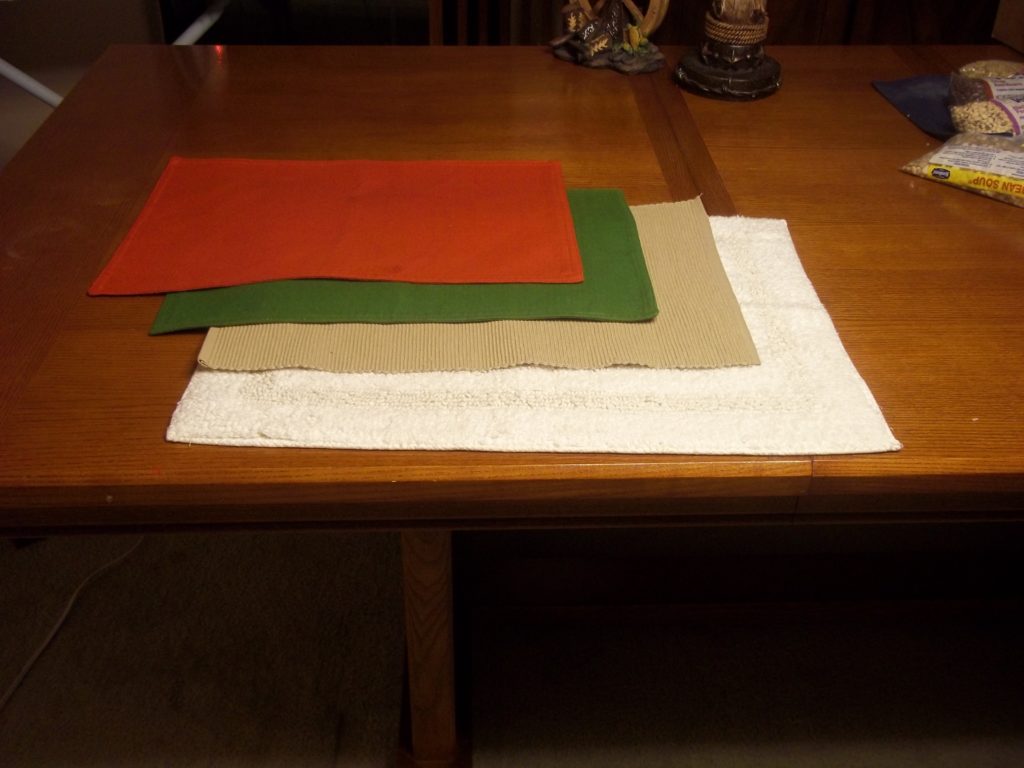
Mats, tables, and open floor space are another key component of the Montessori classroom. Some activities are best worked with on tables; other activities are best completed on mats. In addition, the floor should contain ample open space in order to provide room for group time as well as for spreading mats on the floor to complete activities.
In a classroom setting, you will want to have some child sized tables for children to use while working on Practical Life activities such as pouring and scooping. When choosing tables for your Montessori Practical Life area, wood or natural colored tables are preferable. These will enhance the beauty and appearance of your Montessori environment.
In a home environment, you may choose to have children simply sit at your kitchen table. Just make sure that your child is sitting up high enough (using a booster seat if necessary) to be able to have a comfortable range of motion and be able to complete activities with accuracy. Mats can be utilized equally well in both classroom and home environments. Mats have a special purpose as they designate a child’s space. Children should place their mats on the floor and spread them out neatly. Teach the children to use the mats as an important space. Walk around mats. Never step on top of mats. Children should not touch or take things from another child’s mat. This is a special place designated for one child and his materials.
Selecting Mats
Mats for Montessori activities can be purchased online and through Montessori catalogs. These can be expensive. A good alternative to such purchases is to look at your local discount store for appropriate items which can be used as Montessori mats. If you are choosing a mat for a child or children in your home, then one mat per child should be sufficient for your needs. If you are choosing mats for a classroom of children, then it is a good idea to purchase mats in two or three different sizes. Smaller mats are good for small activities which are easily completed on the floor. These are easier for smaller children to handle and small mats will also take up less floor space. Larger mats are a good choice for activities which can take up a significant amount of room.
Good choices for affordable mats include small floor rugs, bathroom rugs, and accent rugs. For small mats, placemats are a good choice. When choosing your mats, look for simple mats in a solid color. White, off white, and earth tones are good color choices. Other colors can be utilized as well. The solid color is important because it is basic, and it makes it easy for small children to find all of the pieces to an activity on these mats. When a mat has many colors, sometimes activity pieces are harder to see and it also creates a very “busy” background for concentration. It is also best to look for mats made of materials that can be laundered. This is especially important in group environments to clean stains, and sanitize materials used repeatedly by multiple children.
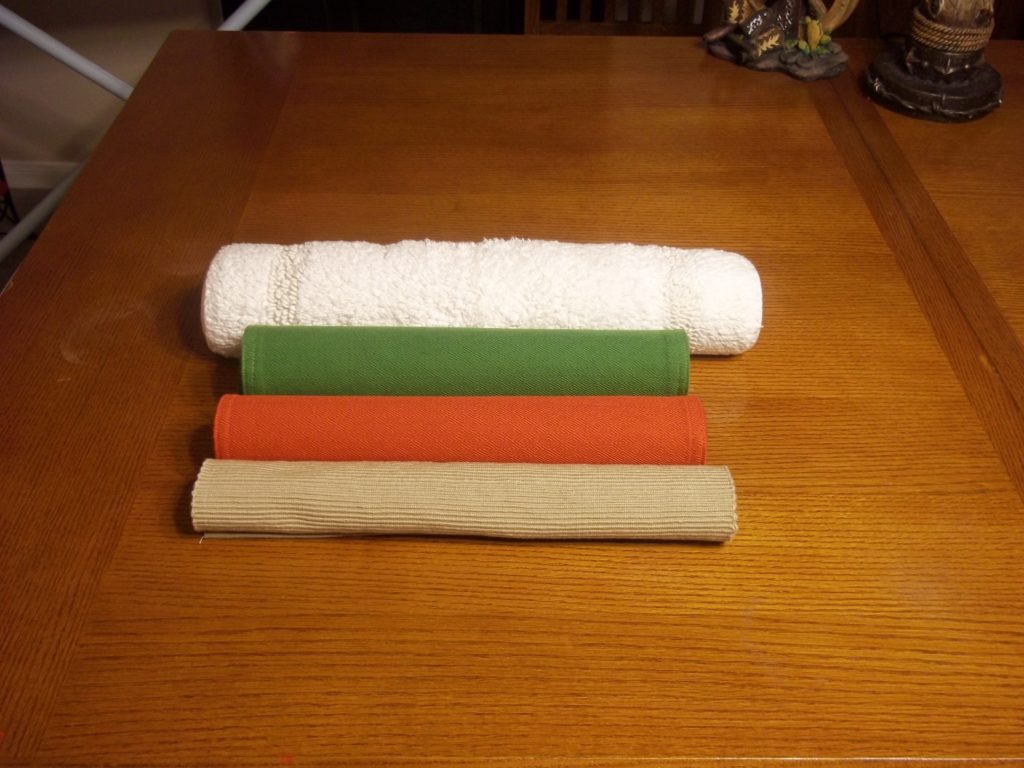
Traditional storage of mats in the Montessori environment includes rolling up the mats; therefore, it is best to choose mats that can be easily rolled up as shown in the example. These mats can be stored in attractive straw baskets to continue the natural look of your Montessori environment.
Mats as Workspaces
The mat should be used by the child just as a table would be used. Teaching a child to use a mat as a workspace means demonstrating how to choose a mat from the storage basket; take it to the work area; lay it on the floor; unroll the mat on the floor; and smooth out the wrinkles until it is completely flat. Next, the Practical Life activity should be chosen from the shelf and carried to the mat. Place the work on the mat and then sit on the floor beside the mat. The mat provides a place for the materials and a designated work space for the child. The child should not sit on the mat.
This designated space provides not only a comfortable place for children to work but the children understand that they don’t have to worry about another child taking their things when they get up for a restroom break, snack or other reason. This was often one of the first things that concerned children when they began classes at my Montessori preschool. Children who came from more traditional child care settings were often concerned about their things being taken by another child if they left their mat for a moment. They were comforted in the structure and atmosphere of a classroom which respects each individual’s space and learning opportunities.
In a classroom setting, often it is the parents who need to be educated about the use of mats. It is very common for parents to walk through a classroom where children are working and step on numerous mats as they cross the floor. Advise your parents on the purpose of the mats and the importance of respecting the materials and space.
All of the information here and much more is available in my book: Montessori Made Easy: Practical Life Lessons available from Amazon.com. There is a link on the “Dr. Andrea’s Books” page.
